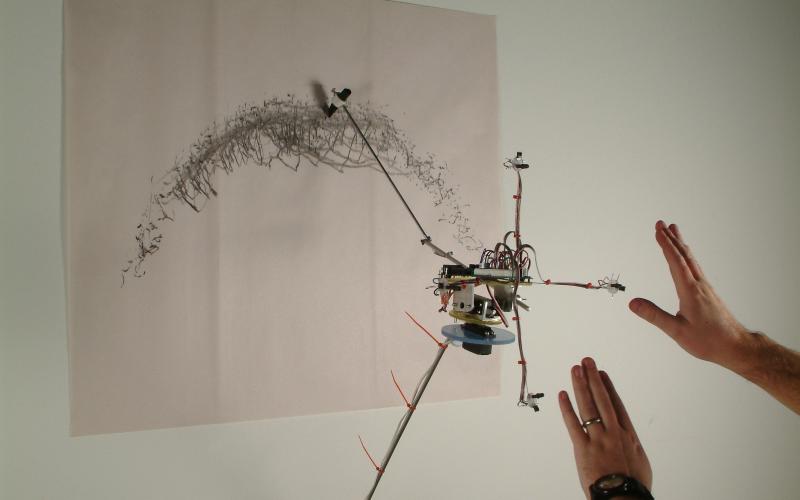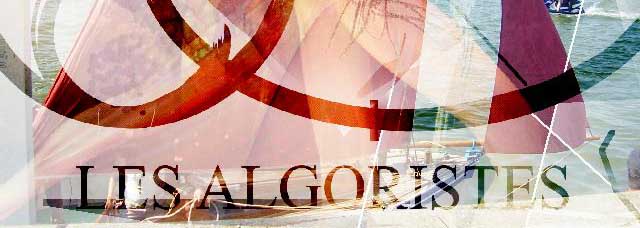
Drawn from a Score: Digital Art Founders Meeting
Oct. 7, 2017 - Feb. 3, 2018. Irvine CA. More info
Artists list : an impressive casting of digital art stars.
Alison Knowles, Casey Reas, Channa Horwitz, David Bowen, Frederick Hammersley, Frieder Nake, Guillermo Galindo, Hiroshi Kawano, Jason Salavon, Jean-Pierre Hebert, John Cage, Leon Harmon & Kenneth Knowlton, Manfred Mohr, Nathalie Miebach, Rafael Lozano-Hemmer, Sean Griffin, Shirley Shor, Sol LeWitt, Vera Molnar
"Drawn from a Score" features artists whose work emanates directly from a written, visual or code-based score. Ranging from event scores first developed by John Cage and Fluxus artists in the late 1950s to contemporary uses of code as a score for computational works, the exhibition includes drawings, sculptures, performances, video projections and computer-generated forms of art.
The exhibition begins with John Cage’s "Fontana Mix" (1958). In his seminal course at the New School for Social Research, Cage taught young artists how to write event scores using chance operations, found sound, and everyday objects to produce live performances. The exhibition will include a reconstruction of Cage’s "Reunion" (1968) ––his chess board that triggers sound while the game is being played––underlining his idea of “indeterminacy.” John Cage coined this term during a series of lectures he gave in 1956, in which he outlined how indeterminacy played a role in performances since the era of Bach. His description was, "a performance of a composition which is indeterminate of its performance is necessarily unique. It cannot be repeated. When performed for a second time, the outcome is other than it was. Nothing therefore is accomplished by such a performance, since that performance cannot be grasped as an object in time."
The works in this exhibition bridge the gap between written scores and computer programs that use chance (and other computational techniques) to create non-repeating variations. "The House of Dust" (1971)—a collaboration between Fluxus artist Alison Knowles and the composer James Tenney that yielded the first computer-generated poem created in the programming language Fortran—will be represented by both static and live versions of the original score. Also included in the exhibition will be works by Manfred Mohr and Vera Molnar (among others), who also used Fortran to make plotter prints a few years after Knowles. Sol Lewitt’s site-specific installation, "Wall Drawing 76" (1971), is created by following a set of written "instructions" (or a score, so to speak) written by the artist. Overseen by a draftsperson from the Sol LeWitt estate, LeWitt’s installation of graphite lines on a wall of the gallery will be rendered by several graduate students from the UC Irvine Department of Art; marking an important and once-in-a-lifetime opportunity for UC Irvine's young artists.
Some of the more contemporary works in this exhibition use computer generated or real-time animation in projections. Los Angeles-based Casey Reas expands on Sol Lewitt’s instructions by writing computational scores to make infinitely mutable digital images on monitors. Israeli artist Shirley Shor’s "Landslide" (2004) uses computationally generated imagery to project virtual compositions on the physical surface of white sand, a constantly changing topography that alludes to geo-politics.
Free special events and performances relating to the exhibition will take place throughout the exhibition's duration; please check our website for more information under the "Events" tab.
This exhibition is possible due to the generosity of the Beall Family Foundation.
We would also like to thank our featured lenders: The John Cage Trust (Red Hook, NY), Orange County Museum of Art (CA), the Anne and Michael Spalter Digital Art Collection (Providence, RI), and the Carl & Marilynn Thoma Art Foundation (Chicago, IL / Santa Fe, NM).
A free LASER Talk about the use of scores in art will take place on Monday, October 9, 5:30-7:30pm at UCI Applied Innovation. Registration is open now through the UCI Illuminations Fund Page - a fund that has generously funded this series for the 2018 season.

